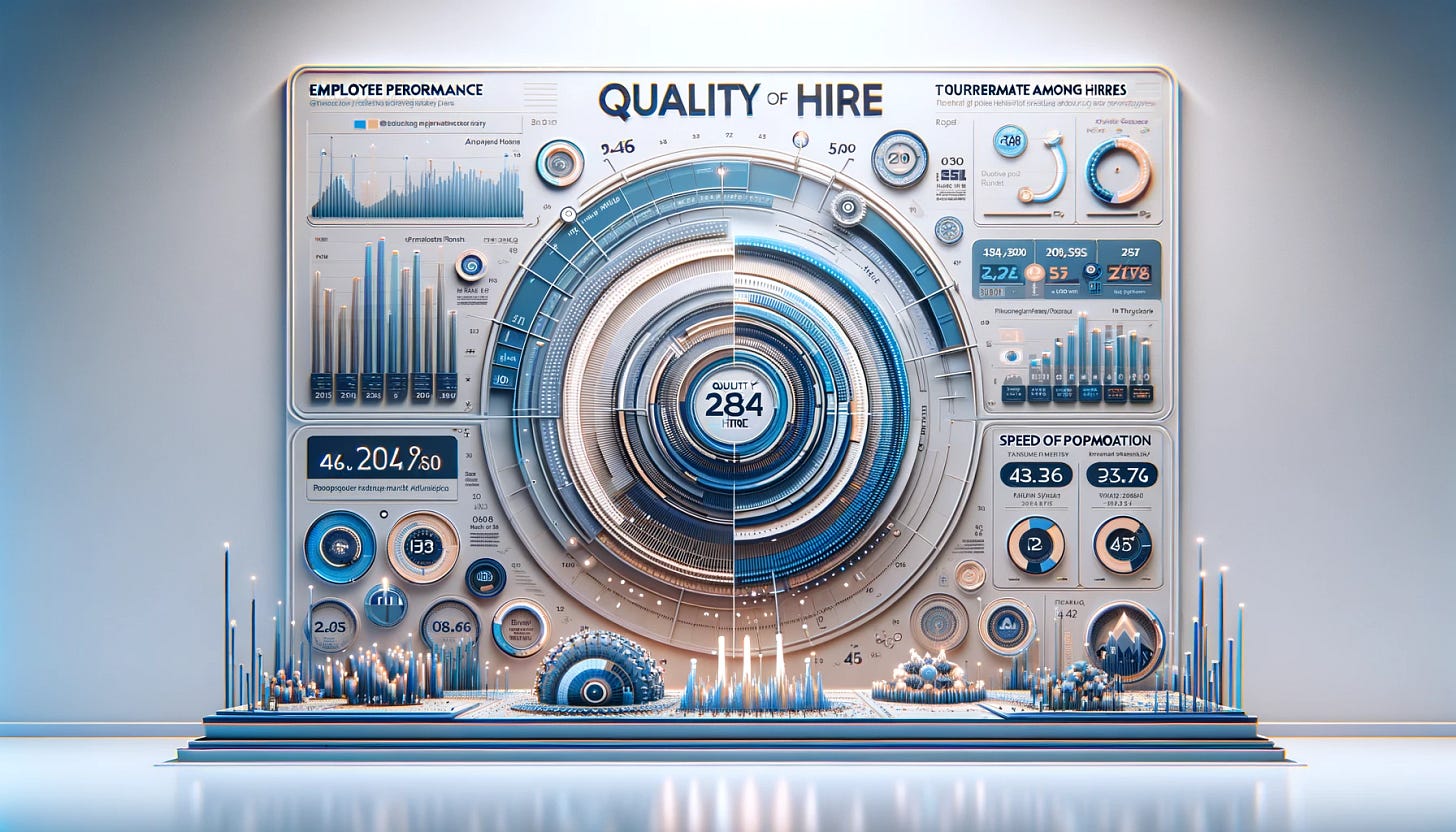Power of Data: Recruiting Metrics for 2024 Success
Elevate your recruitment game with data-driven metrics. Discover the most important KPIs to track and analytical approaches for informed decision-making in 2024.
Imagine you're planning a cross-country road trip. You've got your destination in mind, but without a map or any idea of the best routes, you'll be driving blind. Sure, you might eventually get there, but you'll waste countless hours stuck in traffic, and hit every possible detour.
Now, think about your recruitment efforts. Are you taking the same blind approach, relying solely on instinct and gut feelings? Or are you leveraging the powerful insights that data can provide, allowing you to navigate the twists and turns of the talent landscape with precision and efficiency?
Data-driven recruiting isn't just a nice-to-have – it's an absolute necessity. By tracking and analyzing the right metrics, you'll gain a clear understanding of what's working, what's not, and where you need to course-correct. It's like having a real-time GPS system that guides you toward your ultimate goal: attracting and hiring the best possible talent for your organization!
But with so many metrics to choose from, it can be easy to get overwhelmed or lose sight of what really matters. That's why, in this article, we'll cut through the noise and focus on the several key recruiting metrics that should be at the top of your dashboard in 2024.
These aren't just random numbers — they're powerful indicators that can help you:
Streamline your hiring process and reduce time-to-fill
Identify your most fruitful talent sources and optimize your recruitment spend
Ensure you're bringing in top-notch candidates who are a perfect fit for your company culture
Win over the best and brightest by crafting irresistible offers
Stretch your recruitment budget further without sacrificing quality
With the right metrics as your co-pilot, you'll navigate the talent highway like a pro, leaving your competitors in the dust.
Here's the first section covering the key recruiting metrics to focus on in 2024:
The Metrics That Matter Most in 2024
These are just a few key recruiting metrics that you should focus on, but always prioritize what is beneficial to your company.
1. Time-to-Fill: Understanding the True Cost of Lengthy Hiring Cycles
In the world of business, time is money. Every day a critical role remains unfilled, your team's productivity takes a hit, and your competitors gain an edge. That's why time-to-fill is such a crucial metric to track. It measures the number of days between when a job requisition is opened and when an offer is accepted by the ideal candidate.
Sure, you could rush to fill roles as quickly as possible, but that's a surefire way to make costly mis-hires. The key is finding the sweet spot – minimizing your time-to-fill without sacrificing quality. Industry benchmarks can vary, but in general, you'll want to aim for 30-55 days for non-executive roles (depending on the roles, seniority, etc).
Calculation Example
Time to fill is calculated by taking the date an offer is accepted and subtracting the date the job was posted. The total is then divided by the number of filled positions to get an average time-to-fill.
Formula: Time-to-Fill = (Date of Offer Acceptance - Date of Job Requisition) / Number of Positions Filled
2. Source of Hire: Unveiling the Most Fruitful Talent Pipelines
Have you ever felt like you're throwing darts in the dark when it comes to deciding where to invest your recruitment marketing efforts? Well, those days are over. By closely tracking your source of hire, you'll gain invaluable insights into which channels are delivering the best return on investment.
Maybe you've been pouring resources into job boards that barely yield a trickle of qualified candidates. Or perhaps you've been sleeping on the power of employee referrals, which often provide some of the highest-quality hires. Whatever the case may be, this metric will shine a light on your most fruitful talent pipelines, allowing you to double down on what works and cut loose what doesn't.
Calculation Example
It's often calculated as a percentage. The total number of hires from a specific source is divided by the total number of hires in a period, then multiplied by 100.
Formula: Source of Hire (%) = (Number of Hires from a Source / Total Number of Hires) × 100
3. Quality of Hire: Ensuring Long-Term Success with the Right Fit
Let's be real – making a bad hire can be a nightmare. From subpar performance to cultural misalignment to costly turnover, the ripple effects can be disastrous. That's why quality of hire is arguably the most crucial metric of all. But how exactly do you measure it?
There's no one-size-fits-all approach, but some common methods include tracking new hire performance reviews, gathering hiring manager feedback, and monitoring retention rates. The goal is to gauge how well your new employees are meeting (or exceeding) expectations and thriving in their roles.
By zeroing in on quality of hire, you'll be able to continuously refine your sourcing strategies, assessment tools, and overall hiring process. It's all about bringing in those A-players who will stick around for the long haul and propel your company forward.
Calculation Example
It's often measured over a certain period (like one year after hire).
Formula: Quality of Hire = ((Performance Rating + Goal Achievement + Cultural Fit Score + Retention Rate) / 4) × 100
Explanation of each component:
Performance Rating: This is a score or assessment of the new hire’s job performance, typically evaluated by their supervisor.
Goal Achievement: Measures how well the new hire meets or exceeds specific predefined goals or objectives relevant to their role.
Cultural Fit Score: Assesses how well the new hire aligns with the company's values and culture, often gathered through surveys or feedback from peers and managers.
Retention Rate: Reflects the new hire’s longevity and commitment to the organization, indicating their satisfaction and fit within the company.
Each component is given equal weight in this formula, and the result is multiplied by 100 to express it as a percentage. This approach provides a more rounded and nuanced view of how effectively new hires are integrating and contributing to the organization.
However, it's important to tailor the formula to your organization's specific needs and priorities, as different companies may value different aspects of employee performance and fit.
4. Offer Acceptance Rate: Winning the War for Top Talent
You've sourced an incredible candidate who checks all the boxes. They sailed through the interviews and everyone is eager to bring them on board. But then, they surprisingly turn down your offer. It's a gut-punch scenario that plays out far too often. By tracking your offer acceptance rate, you'll gain valuable insights into where you might be falling short in your hiring process and employer brand.
Are your compensation packages lagging behind the market rate? Is your recruitment team failing to effectively "sell" candidates on the benefits of joining your company? Or are competitors simply doing a better job of wowing top talent? Whatever the root causes, a low offer acceptance rate is a red flag that you need to up your game.
Ideally, you'll want to sustain a 90+% acceptance rate. Anything lower could signal underlying issues that are costing you top candidates and hindering your ability to build a high-performing team.
Calculation Example
It's calculated by dividing the number of accepted offers by the total number of offers made, then multiplied by 100.
Formula: Offer Acceptance Rate (%) = (Number of Accepted Offers / Total Number of Offers) × 100
5. Cost-per-Hire: Balancing Efficiency and Effectiveness
Hiring is an investment – and like any smart investor, you need to keep a watchful eye on your returns. That's where cost-per-hire comes into play. This metric takes into account all the internal and external expenses associated with filling a role, including agency fees, job board costs, recruitment marketing, relocation expenses, and more.
On the surface, it may seem logical to try to drive this number as low as possible. But be careful – if you start pinching pennies by skimping on crucial aspects of your recruitment process, you run the risk of compromising quality. It's all about striking the right balance.
By calculating and analyzing your cost-per-hire, you can identify areas for cost optimization while still investing in the resources needed to attract top talent. Maybe you can negotiate better rates with staffing agencies or make smarter use of lower-cost sourcing channels. The key is making data-driven decisions that maximize your return on hiring investment.
Calculation Example
This metric calculates the total cost of hiring new employees. It includes advertising fees, recruitment event costs, recruiter salaries, candidate travel expenses, relocation expenses, and any other costs associated with the process. The total cost is divided by the total number of hires.
Formula: Cost-per-Hire = Total Recruitment Costs / Total Number of Hires
6. Hiring Velocity Rate
This metric measures the number of roles you are able to fill over a specific period of time compared to your hiring needs and capacity. It reveals whether your recruiting engine is firing on all cylinders.
Calculate it by taking the number of actual hires made divided by the number of roles you targeted to fill over a set time frame (e.g. quarter). A rate of 1 means you perfectly match your hiring needs.
A low rate could signify inefficiencies, roadblocks or capacity issues in your recruiting process. Tracking this focuses efforts on maximizing your hiring output.
While more difficult to measure, unique metrics like these can highlight issues and opportunities that traditional metrics miss. Leading companies are evolving to take a more multi-dimensional approach to recruiting analytics.
Hiring Velocity Rate Calculation Example
Time Frame for Calculation: Quarter (3 months)
Total Number of Open Positions at Start of Quarter: 20
Number of Positions Filled During Quarter: 15
Calculation:
Hiring Velocity Rate = (Number of Positions Filled / Total Number of Open Positions) × 100%
Hiring Velocity Rate = (15 / 20) × 100% = 0.75 × 100% = 75%
Result: The Hiring Velocity Rate for the quarter is 75%. This means that the company filled 75% of its open positions during this quarter.
Harnessing the Power of Analytics
Tracking metrics is one thing, but translating that raw data into actionable insights is where the real magic happens. That's why having the right technology stack and analytical capabilities in place is so crucial.
Start by leveraging your applicant tracking system (ATS) and recruitment marketing platforms to their full potential. Most modern solutions offer robust reporting and analytics features that can help you easily visualize key metrics and spot trends over time.
But don't stop there – the most successful data-driven recruiting strategies integrate data from multiple sources, creating a comprehensive view that connects the dots between your various hiring activities. For example, you could link your source data to downstream metrics like quality of hire to determine which channels are yielding your best long-term employees.
As you accumulate data over time, you'll be able to establish benchmarks and set realistic but ambitious targets for continuous improvement. For example, you might aim to reduce your time-to-fill by 10% year over year or boost your offer acceptance rate to the elusive 90th percentile.
The true power of analytics, however, lies in the ability to regularly review your performance, quickly identify areas of opportunity, and pivot your strategies on the fly based on real-time insights. It's an ongoing cycle of measurement, optimization, and refinement that will keep you persistently marching toward better results.
That said, numbers alone won't carry you to success. You'll need to combine data-driven decision-making with creative, innovative tactics and a keen understanding of what motivates and resonates with your target talent pools. Used in tandem, quantitative metrics, and qualitative insights become a potent force for recruiting excellence.
Recruiting Metrics
By keeping a firm grip on the metrics that matter most, you'll avoid getting lost down endless dead-end roads. You'll spend less time aimlessly circling the same blocks, and more time charting the most direct path toward building an unstoppable team of top performers.
But let's be real—the road ahead won't always be smooth. You'll hit pockets of traffic caused by economic shifts, and detours will pop up as new hiring trends emerge. That's why data-driven agility is so crucial. Don't just set your metrics on cruise control. Consistently reassess, recalibrate, and reimagine your strategies based on the latest analytics.
Embracing a data-driven mindset means having the courage to ditch tactics that aren't delivering results, no matter how married you may be to traditional approaches. It's about bringing an open, curious, and innovative spirit to the new realities the numbers reveal.
Will you encounter some roadblocks along the way? Of course. But with metrics as your co-pilot, you'll be able to course-correct quickly and stay laser-focused on your destination: talent acquisition supremacy.
Key Metrics That Tell the Truth
Key metrics serve as powerful tools that can reveal underlying issues in your hiring and retention strategies, often overlooked yet critical for organizational success. To gain a comprehensive understanding of your company's health in these areas, let's delve deeper into the two essential metrics you should be consistently monitoring as well.







